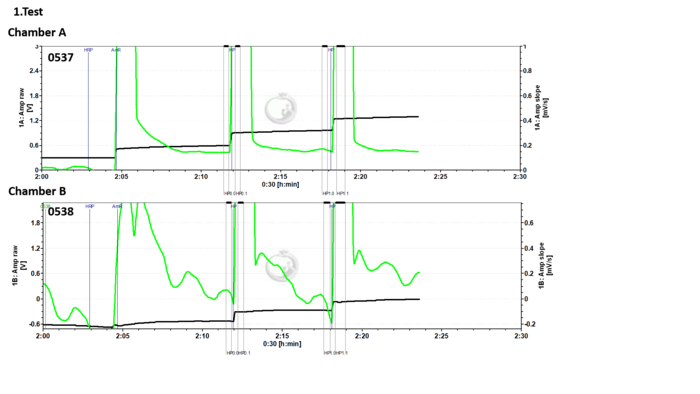From Bioblast
 |
Troubleshooting: fluorescence module |
MitoPedia: Oroboros Open Support
In the following page, the most common problems occurring with either the Fluo Smart-Module or Fluo LED2-Module are summarized. The problem can be related to (a) the fluorescence settings in DatLab, (b) the fluorescence sensors, (c) the Fluorescence-Control Unit (in the case of the Fluo LED2-Module), or (d) the Oroboros.
Zero fluorescence signal
- Problem: The raw fluorescence signal is 0 V with and without the fluorescence dye.
- Solution: To identify and resolve the cause of the problem, please go through the following check-list:
- 1. For O2k series H and higher, check that the Fluo-Sensors are connected to the O2k and inserted into the Oroboros chamber front window in the correct position. See: Fluo Smart-Module:Connect Fluorescence-Sensor.
- 2. For O2k series D-G, check that the Fluorescence-Control Unit is properly connected to the O2k and switched on.
- 3. In DatLab check that:
- a) the chamber illumination is switched off in the ´O2k control´window.
- b) the Fluo intensity is set to a number greater than 0 in the 'Amperometric,Amp' tab of the ´O2k control´ window. To test whether it works, set the gain for Fluo-sensor at the maximum.
- 4. If all the above-mentioned settings and setup are correct and the detected signal with the Fluo-Sensor is still 0, perform the following test to localize the problem:
- Add distilled water or respiration medium into the Oroboros chamber (without sample and fluorescence dye), insert the black stopper and change the settings for fluorometric measurements: Gain=1000; Fluo intensity (Serie H or higher) or Polarization voltage (Series D-G)=500.
- Let it run for 5 min with Fluo-Sensor A in chamber A and Fluo-Sensor B in chamber B.
- Swap the Fluo-sensors and set event “swap sensor”, write in the comment box which sensor is in which chamber.
- Let it run for 5 min.
- If the problem is with the Fluo-Sensor, the fluorescence signal will be 0 V with the faulty Fluo-Sensor in both chambers. In this case, the Fluo-Sensor should be shipped to us for repairs.
- If the problem is with the Oroboros or the LED2 Fluo-Module, 0 V fluorescence signal can be observed just in one chamber with two different Fluo-Sensors. In this case, the O2k or the Fluorescence-Control Unit (Series D-G) should be shipped to us for repairs. In some cases, the defect of the Fluorescence-Control Unit (Series D-G) leads to 0 V in both chambers.
- Add distilled water or respiration medium into the Oroboros chamber (without sample and fluorescence dye), insert the black stopper and change the settings for fluorometric measurements: Gain=1000; Fluo intensity (Serie H or higher) or Polarization voltage (Series D-G)=500.
- Please contact our Oroboros Open Support to analyze your problem before shipment. Be sure to always send us original DatLab files with the above-mentioned tests to evaluate Fluo-Sensor performance.
- 3. In DatLab check that:
Noisy fluorescence signal
- Problem: The raw fluorescence signal is noisy to such an extent that the evaluation of the results is not possible.
- Solution: To localize the problem, perform the following test:
- Add distilled water or respiration medium into the Oroboros chamber (without sample and fluorescence dye), insert the black stopper and change the settings for fluorometric measurements: Gain=1000; Fluo intensity (Serie H or higher) or Polarization voltage (Series D-G)=500.
- Let it run for 5 min with Fluo-Sensor A in chamber A and Fluo-Sensor B in chamber B.
- Swap the Fluo-sensors and set event “swap sensor”, write in the comment box which sensor is in which chamber.
- Let it run for 5 min.
- If the problem is with the Fluo-Sensor, the fluorescence signal will be noisy with the faulty Fluo-Sensor in both chambers. In this case, the Fluo-Sensor should be shipped to us for repairs.
- If the problem is with the O2k or the LED2 Fluo-Module, the fluorescence signal is noisy in one chamber with two different Fluo-Sensors (see example below). In this case, the O2k or the Fluorescence-Control Unit (Series D-G) should be shipped to us for repairs. If the noise occurs in both chambers, the Fluo-Sensors and the O2k (and Fluorescence-Control Unit - series D-G) should be shipped to us.
- Please contact our Oroboros Open Support to analyze your problem before shipment. Be sure to always send us original DatLab files with the above-mentioned tests to evaluate Fluo-Sensor performance.
- Example: Problem with O2k or LED2 Fluo-Module
- Provided by Hazirah Hassan, University Kebangsaan Malaysia, hazy_hassan@yahoo.com



- After changing the Fluo-Sensors between the Oroboros chambers, the problem is related to the O2k or LED2 Fluo-Module since the fluorescence signal is negative and unstable in chamber B with both Fluo-Sensors. In the third figure, the fluorescence signal is very unstable in chamber B, which makes the experiment hard to interpret. Both the O2k and the LED2 Fluo-Module should be shipped to our electronic workshop.
Negative fluorescence signal
- Problem: The fluorescence signal of one Fluo-Sensor is negative.
- Solution: To localize the problem, perform the following test:
- Add distilled water or respiration medium (without sample and fluorescence dye) into the Oroboros chamber, insert the black stopper, and change the settings for fluorometric measurements: Gain=1000; Fluo intensity (Series H or higher) or Polarization voltage (Series D-G) = 500.
- Let it run for 5 min with Fluo-Sensor A in chamber A and Fluo-Sensor B in chamber B.
- Swap the Fluo-sensors and set event “swap sensor”, write in the comment box which sensor is in which chamber.
- Let it run for 5 min.
- The problem is related to one of the Fluo-Sensors, if you observe a negative signal in both chambers after swapping them. The negative signal might be related to a wet plug of the Fluo-Sensor. The solution is to dry it out with e.g. a hairdryer and let it run connected to the Oroboros (25 °C, illumination off, distilled water in the Oroboros chamber, gain for Fluo-Sensor 1000, fluorescence intensity=500) for a couple of days in a dry and warm environment. Or dry in a laboratory oven at a maximum of 60 °C for 1-2 h. If this treatment does not solve the problem and you get still negative fluorescence values, the Fluo-Sensor should be sent back to us for further investigation.
- Please contact our Oroboros Open Support to analyze your problem before shipment. Be sure to always send us original DatLab files with the above-mentioned tests to evaluate Fluo-Sensor performance.
- Example: Provided by Anne Laure Charles, FR_Strasbourg_Zoll J,anne laure charles <anne.laure.charles@outlook.fr

- The fluorescence signal was negative in both chambers after swapping the Fluo-Sensors, but the signal changed after swapping the sensors, which means that the problem is located to the Fluo-Sensors. In this case, both Fluo-Sensors should be shipped to the electronic workshop.
Fluorescence signal is constantly at 10 V
- Problem: The fluorescence signal is constantly at the 10 V upper limit when using the Fluo Smart-Module or Fluo LED2-Module.
- Solution: This is probably due to high light exposure to the photodiode. Check the following parameters:
- 1. The chamber illumination must be switched off. Check it in the `O2k control´ window.
- 2. The photodiode filters must be inserted, otherwise the light emitted from the LED will not be filtered. Information on how to mount the filter cap- » here.
- 3. Black PEEK stoppers must be used.
- 4. The fluorescence intensity should not be set too high. The settings might vary for each application or fluorophore. Check also the gain (amplification of the signal) settings. If necessary, decrease fluorescence intensity and/or gain to obtain an initial voltage lower than 5 V, but higher than 0 V. Check in the Amperometric,Amp tab of the ´O2k control´ window.
- If all the above-mentioned settings and setup are correct and the detected signal is still at 10 V (out of scale), the O2k (and Fluorescence-Control Unit - series D-G) or/and the Fluo-Sensors should be shipped to us.
- Please contact our Oroboros Open Support to analyze your problem before shipment. Be sure to always send us original DatLab files with the above-mentioned tests to evaluate Fluo-Sensor performance.
High fluorescence signal
- Problem: The fluorescence signal is suddenly higher in one or both chambers even before adding dye or sample.
- Solution: The problem might be related to the position of the filters inserted onto the Fluo-Sensors. First, check whether the filters are in the correct position and have not shifted. If this does not solve the problem, perform the following test to localize the problem:
- Add distilled water or respiration medium into the Oroboros chamber (without sample and fluorescence dye), insert the black stopper and change the settings for fluorometric measurements: Gain=1000; Fluo intensity (Serie H or higher) or Polarization voltage (Series D-G)=500.
- Let it run for 5 min with Fluo-Sensor A in chamber A and Fluo-Sensor B in chamber B.
- Swap the Fluo-sensors and set event “swap sensor”, write in the comment box which sensor is in which chamber.
- Let it run for 5 min.
- If the problem is with one of the Fluo-Sensors, the fluorescence signal will be high with the faulty Fluo-Sensor in both chambers. In this case, the Fluo-Sensor should be shipped to us for repairs.
- If the problem is with the O2k or the LED2 Fluo-Module, the fluorescence signal is high in one chamber with two different Fluo-Sensors. In this case, the O2k or the Fluorescence-Control Unit (Series D-G) should be shipped to us for repairs. If the signal is high in both chambers, the Fluo-Sensors and the O2k (and Fluorescence-Control Unit - series D-G) should be shipped to us.
- Add distilled water or respiration medium into the Oroboros chamber (without sample and fluorescence dye), insert the black stopper and change the settings for fluorometric measurements: Gain=1000; Fluo intensity (Serie H or higher) or Polarization voltage (Series D-G)=500.
- Please contact our Oroboros Open Support to analyze your problem before shipment. Be sure to always send us original DatLab files with the above-mentioned tests to evaluate Fluo-Sensor performance.
- For more information on how to assemble the Fluo-Sensors and how to change the filters, see:
- » Smart Fluo-Sensor assembly
- » Exchanging a filter set of the Fluo-Sensors



